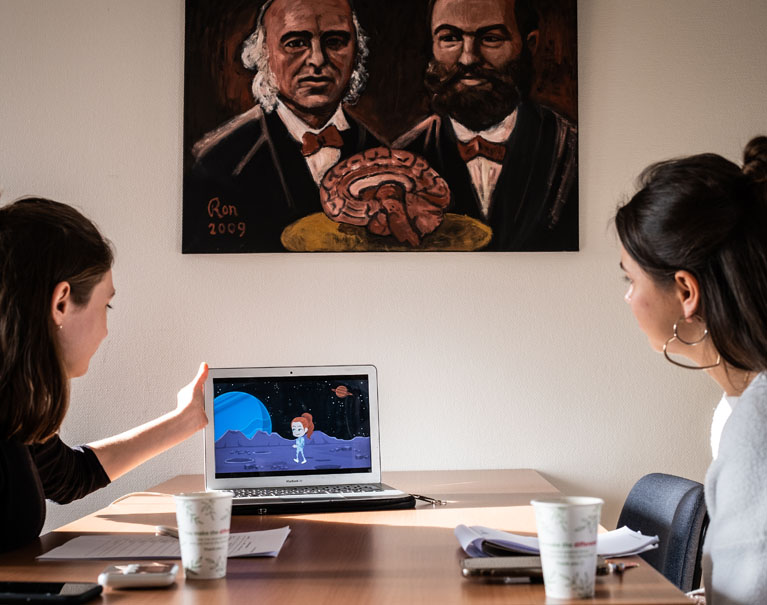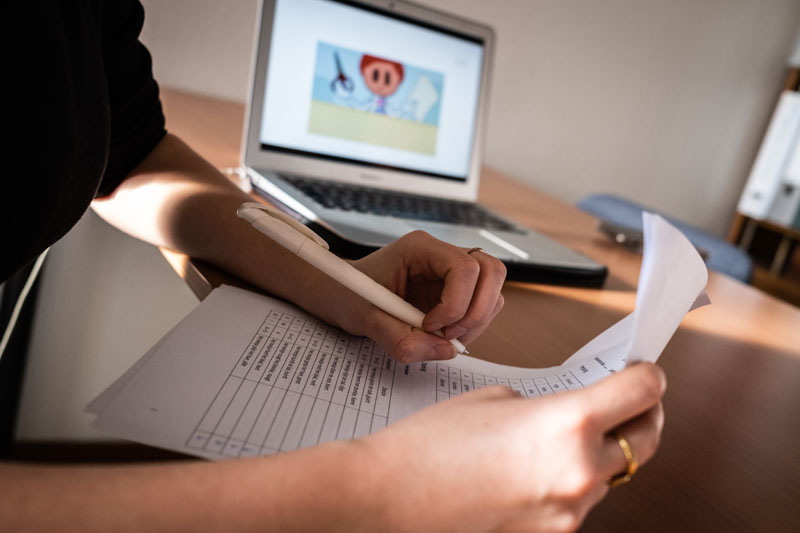
Guinea pigs #8Testing for a language deficiency
‘Glurp? Gloon? What is the girl doing?’
On the lookout for a scientific experiment to submit myself to, I come across a study by Cheyenne Svaldi and Kim Vos. ‘Do you want to help us improve our methods to determine language deficiencies in children?’ they ask. While I’m not exactly the target for this study, I am intrigued. Today, just for show, I’ll be doing a bunch of tests aimed at children between four and twelve years old.
Children suffering from developmental language disorder (DLD) have trouble learning language, Cheyenne explains after we meet at the Harmonie building. This leads to problems using verbs or making sentences, among other things. It can be difficult for them to have a normal conversation that flows well.
There aren’t any reliable tests to determine these language issues in kids, but the researchers hope to change that. They’ve developed several tests that speech therapists can use to provide more focused therapies. But first, they need thorough testing on children both with and without a DLD.
Remembering words
Cheyenne tells me I’ll be taking three tests. I hesitantly ask if she thinks I’ll score like a child with normal language development, or one with DLD. She laughs in response, so I think I’ll probably score in a normal range.
In the first test, I’m tasked with remembering fifteen words. That actually sounds pretty tricky. I try to focus as I listen to a recording of the words. I can remember seven of the fifteen and repeat them as quickly as I can: curtain, bird, pencil, glasses, sponge, drum, sky. I think hard, but I can’t remember the rest. ‘That’s it’, I say, ashamed. Surely today won’t reveal that I have a language deficiency?
We listen to the words again. After a few times, I remember twelve out of the fifteen. Not bad, Cheyenne tells me. I ask her the minimum age for this test: six years, she says. Aha.
Verbs
I start the second test, which is all about verbs. A laptop screen shows me an animated astronaut and an alien. They talk and I have to repeat them out loud. ‘The man weighs the boy.’ I repeat the sentence: piece of cake. ‘The man dries the boy.’
Next, the voice says it’s time to start. Apparently, this was just a practice round. I tell myself to focus. I have to describe what I’m seeing on the screen. What is the man doing? He’s scrubbing the table. I’m doing pretty well in this test.
‘Working with kids isn’t the same as working with adults’, says Cheyenne. ‘You have to be more playful. It’s not unusual for us to play a little game in between tests to ensure they stay focused. The astronaut and the alien, which were designed by the ALFA university, aid in that, too.’

Pilking and railping
The last test involves the alien and the astronaut as well. This time, I have to repeat fake verbs. Gloon, noog, pilk, railp, feme, han, gorp, kour, lire. This is the pre-training, says Cheyenne. I’m okay repeating the sentences: The girl kours the ball. The girls noogs the drink. The girl pilks the hair.
But then, the videos are played again, and I have to describe the girl’s actions. Is she glurping? No, says the screen, she’s glooning. The next picture has me stumped. I also draw a blank at the one after that. Cheyenne reassures me. ‘This is normal. We have to make that connection between a new word, its pronunciations, and its meaning. Only then are we able to remember it.’
Despite her efforts, I’m a little peeved. This test is for eight- to twelve-year-olds. I’m twenty-one, and I’m struggling. After five minutes, I’m finally starting to recognise the pictures. The girl is railping the drink!
Match game
Once I reach the final part of the test, I’m doing much better. Here, all I have to do is match the verbs with a picture, and I get every single one of them correct. I’m very proud of myself. ‘As you can see, understanding and indicating words is much easier than effectively reproducing them’, says Cheyenne.
I feel both satisfied and confused when I leave the room at the end of the session. I may have contributed to the development of new language tests that will hopefully help children with DLD, but the tests were more difficult than I’d anticipated. I guess we’re never too old to learn.
- Faculty: Arts, at the Center for Language and Cognition
- Study: Taal bij TOS-kinderen (only in Dutch)
- Duration: Depending on age, two to three hours
- Remuneration: a children’s book